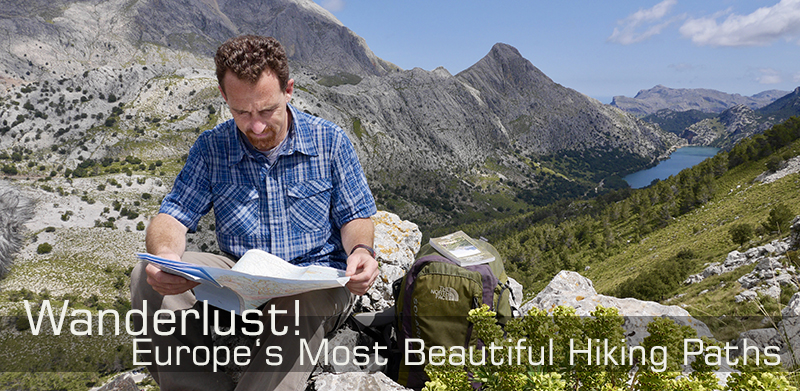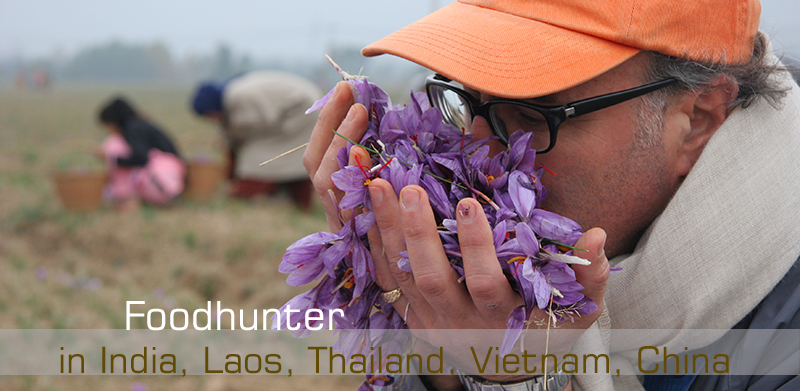
WANDERLUST – EUROPE’S NICEST HIKING TRAILS 2014-2015
10 films x 43 Min., HD, stereo
Coproduction SWR, Arte (Cornwall Coast Path, Crete’s GR7 / Greece, Mallorca Island / Spain, Stevenson Trail / France, Saar-Hunsruck-Steig / Germany, Amalfi Coast / Italy, Andalousia / Spain, Dingle and Kerry Ways / Ireland, Saint Olav Ways / Norway, Lechweg / Austria.).
The documentary series show some of the most beautiful hiking trails of Europe. The documentaries accompany an enthusiastic hiker and trekker : Bradley Mayhew, 43, senior writer for Lonely Planet Publications. With him, the films explore the nature, history and culture of the respective hiking trail, pass the landmarks of the routes, meet exciting people along the way.
For a long time, hiking was considered old-fashioned and sedate. That certainly has changed, and thoroughly. Hiking is trendy, it is teeming with hiking apps, hiking blogs, hiking portals. The new hiker wears outdoor clothing instead of knee breeches and orients himself by GPS. Hiking is green. Hiking is healthy. Hiking is sharing experiences.
On Europe’s most beautiful hiking trails, Bradley Mayhew is always accompanied by a hiking friend from the respective country. Together they meet farmers, hut keepers, priests, winegrowers, biologists, also geocachers, craftsmen and of course other hikers. Through him he gets to know the culture along the hiking trail, and learns more about the nature along the hiking trail, about animals, plants and rocks.

EUROPE’S HIGH SPIRIT – 2012-2015
4 films 4 x 43 Min., HD, stereo
Coproduction SWR and Arte
For many centuries spirits and prime eau-de-vie have been produced all over Europe. Whether vodka, whisky, fruit brandies, or absinthe, Europe’s distillates and essences are a cultural tradition of high level. They are the mirror of the landscapes, the history and the lifestyle of the region, where they are produced.

MARCO POLO RELOADED – 2011
5 films x 43 Min., HD, stereo
Coproduction SWR and Arte
What happens to you today when you follow the trail of the great Venetian traveller, when you travel from Venice to Beijing, along the Silk Road? Along Mekong Productions accompanied Lonely Planet author Bradley Mayhew for many months. 8000 kilometres overland, by bus, truck or hitchhiking, through some of the most inaccessible parts of the world – always following the Marco Polo trail.

DER FOODHUNTER –
Out for Asia’s Culinary Treasures2005-2009
The series:
6 films x 43 Min., 5 x 28 Min. Digibeta, Stereo
Profession: Foodhunter
The film: 43:30 und 58:00
Coproduction SWR & ARTE
Mark Brownstein has an unusual profession. He roams through remote regions of Asia, searching for ancient, forgotten foods and foodstuffs unknown to us, in order to make them accessible to fine cuisine all over the world. He is a foodhunter.
Mark, a US American, is a professional taste hunter who sells his finds to creative chefs. His territory is Asia.
We followed him the first time in 2005/2006 for the film project ‘Profession: Foodhunter’. In 2007 we were again on the road with Mark, this time for a 5-part series of documentaries –‘The Foodhunter. Out for Asia’s Culinary Treasures.. We had the pleasure of following Mark to India, Thailand, Laos, and Vietnam. The films take you from mountain villages, cookshops and jungle markets directly to the luxury restaurants of Asia’s mega-cities. With Mark, we dive deep into the cosmos of Asian cuisines.
In 2009 we produced two new 43 min. episodes with Mark, ‘The Foodhunter in China’.

MARITIME INDIA – SEARCHING FOR THE TRAILS BR – 2003
3 films x 43 Min / Digibeta, Stereo
3 x 52 Min International version
For more than 4000 years, Indian ships sailed on the sea that is not called the “Indian” Ocean without reason. And traders from Arabia and Africa, China and Europe anchored in India’s ports. We know their accounts of spices and precious stones, of silk and cotton cloth, a sea trade that brought wealth to India’s merchants and rulers.
Independent India, socialist in orientation, hardly engaged in foreign trade for decades. But slowly the country is recalling its ports, its coasts and its long history of maritime trade, today, in the age of globalisation.
India’s coastline stretches 5,600 kilometres: from the Pakistani border to the southern tip of the subcontinent and back up to the mouth of the Ganges. The three films follow this coastline in search of traces of India’s great maritime history, a history that is largely unknown even in India. The films move around by sailing dhow, bus or train, meeting the people who live and work on India’s coasts. These people are the focal points of the series.

THREE ROADS TO SAMARKAND – 2000
3 films x 60:00 Digibeta, Stereo
Coproduction BR & ARTE
Three 60-minute films each approach the legendary Samarkand from the very edge of Central Asia. From vast barren landscapes – sandy desert, steppe, high mountains – the films approach the Central Asian heartland with its historic oasis cities like Khiva, Merv or Bukhara. Again and again they linger, immersing themselves in the rich history. They tell stories: about silkworm breeding, the China trade, hardship in Tajikistan, the opera in Tashkent, about Islamic architecture, horse fights, the railway, the everyday life of an Islamic neighbourhood, a mahalla. Above all, the series tries to paint a picture of the culture and cultural change of this unknown region.
For seventy years, Central Asia belonged to the Soviet Union. With their collapse, the Soviet republics of Uzbekistan, Kyrgyzstan, Tajikistan, Turkmenistan and Kazakhstan became independent as new states. Thus, in 1991, a “new” region was created between China, Afghanistan and the Caspian Sea, which, however, is ancient. This is where the Silk Road ran. As a melting pot of many peoples, as a huge land bridge between East and West, Central Asia has connected Orient and Occident since time immemorial.
Three films discover
Film 1 approaches Samarkand from the west through the desert of Turkmenistan. The film addresses the Islamisation of Central Asia.
Film 2 comes from the east, from Tajikistan and Kyrgyzstan. It moves along the “trail of silk” and shows how the Silk Road trade shaped the region.
Film 3 begins in the Siberian north at the Russian border and leads on the “trail of the horsemen” through the steppe of Kazakhstan to Samarkand. It addresses the deep rupture that the Mongol hordes and later the Russian-Soviet period cut into the Islamic culture of Central Asia. It shows how Islam has survived, how and why it is resurgent today.

MEKONG – 1995
4 films x 45 Min., 16 mm, Betacam
Production for SWF, BR und WDR
Rising in eastern Tibet the world’s fifth longest stream flows through Southwest China, Burma, Laos, Thailand, Cambodia and South Vietnam before reaching the South Chinese Sea. The Mekong. Almost 4900 km long, it is one of the longest rivers on earth, and the lifeline of Southeast Asia….
Four films discover
Film 1: Turbulent River in Tibet and Southwest China
Film 2: Mother of Waters in Laos
Film 3: Great Water in Cambodia
Film 4: Nine Dragons in Vietnam
For a long time the Mekong was remote and inaccessible for the western world. Remote, undeveloped, ecologically intact. It had never been travelled along its entire length. It was as late as 1994, when its main source was discovered in the highlands of Tibet. The Along Mekong crew spent almost one year shooting the world’s first documentary. They gained access to areas where no western film team had been before. In 1994, the first Mekong Bridge was opened between Laos and Thailand, and the first mega-dam in China. A new era is on its way. Four films follow the river from the source to the mouth, portraying ordinary people living along the river, focussing on culture and ecology, as well as economical, political and developmental issues. River pilot, rice farmer, fish farmer, city planner – people on the river are fixed points in the programme.
